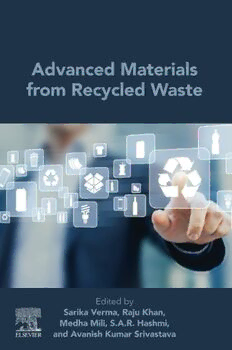
Advanced Materials from Recycled Waste PDF
Preview Advanced Materials from Recycled Waste
ADVANCED MATERIALS FROM RECYCLED WASTE This page intentionally left blank ADVANCED MATERIALS FROM RECYCLED WASTE Edited by S V ARIKA ERMA IndustrialWasteUtilization,NanoandBiomaterials,CSIR-AdvancedMaterialsandProcesses ResearchInstitute(AMPRI),Bhopal,MadhyaPradesh,India AcademyofScientificandInnovativeResearch(AcSIR),Ghaziabad,India R K AJU HAN IndustrialWasteUtilization,NanoandBiomaterials,CSIR-AdvancedMaterialsandProcesses ResearchInstitute(AMPRI),Bhopal,MadhyaPradesh,India M M EDHA ILI GreenEngineeredMaterialsandAdditiveManufacturing,CSIR-AdvancedMaterialsand ProcessesResearchInstitute(AMPRI),Bhopal,MadhyaPradesh,India AcademyofScientificandInnovativeResearch(AcSIR),Ghaziabad,India S.A.R. H ASHMI GreenEngineeredMaterialsandAdditiveManufacturing,CSIR-AdvancedMaterialsand ProcessesResearchInstitute(AMPRI),Bhopal,MadhyaPradesh,India AcademyofScientificandInnovativeResearch(AcSIR),Ghaziabad,India A K S VANISH UMAR RIVASTAVA CSIR-AdvancedMaterialsandProcessesResearchInstitute(AMPRI),Bhopal, MadhyaPradesh,India Elsevier Radarweg29,POBox211,1000AEAmsterdam,Netherlands TheBoulevard,LangfordLane,Kidlington,OxfordOX51GB,UnitedKingdom 50HampshireStreet,5thFloor,Cambridge,MA02139,UnitedStates Copyright©2023ElsevierInc.Allrightsreserved. Nopartofthispublicationmaybereproducedortransmittedinanyformorbyanymeans,electronic ormechanical,includingphotocopying,recording,oranyinformationstorageandretrievalsystem, withoutpermissioninwritingfromthepublisher.Detailsonhowtoseekpermission,further informationaboutthePublisher’spermissionspoliciesandourarrangementswithorganizationssuch astheCopyrightClearanceCenterandtheCopyrightLicensingAgency,canbefoundatourwebsite: www.elsevier.com/permissions. Thisbookandtheindividualcontributionscontainedinitareprotectedundercopyrightbythe Publisher(otherthanasmaybenotedherein). Notices Knowledgeandbestpracticeinthisfieldareconstantlychanging.Asnewresearchandexperience broadenourunderstanding,changesinresearchmethods,professionalpractices,ormedical treatmentmaybecomenecessary. Practitionersandresearchersmustalwaysrelyontheirownexperienceandknowledgeinevaluating andusinganyinformation,methods,compounds,orexperimentsdescribedherein.Inusingsuch informationormethodstheyshouldbemindfuloftheirownsafetyandthesafetyofothers,including partiesforwhomtheyhaveaprofessionalresponsibility. Tothefullestextentofthelaw,neitherthePublishernortheauthors,contributors,oreditors,assume anyliabilityforanyinjuryand/ordamagetopersonsorpropertyasamatterofproductsliability, negligenceorotherwise,orfromanyuseoroperationofanymethods,products,instructions,orideas containedinthematerialherein. ISBN:978-0-323-85604-1 ForinformationonallElsevierpublications visitourwebsiteathttps://www.elsevier.com/books-and-journals Publisher:MatthewDeans AcquisitionsEditor:KaylaDosSantos EditorialProjectManager:IsabellaC.Silva ProductionProjectManager:PremKumarKaliamoorthi CoverDesigner:GregHarris TypesetbySTRAIVE,India Contents Contributors xi Preface xv Acknowledgments xvii 1. Industrial solid waste: An overview N.B.SinghandR.G.Chaudhary 1.1 Introduction 1 1.2 ClassificationofISW 2 1.3 Wastesfromdifferentindustries:Generation,propertiesanduses 4 1.4 Conclusionsandfutureprospects 21 References 22 2. Exploring brine sludge and fly ash waste for making nontoxic radiation shielding materials SarikaVerma,SriparnaPaul,HarshBajpai,Mohd.AkramKhan,andMedhaMili 2.1 Introduction 27 2.2 Brinesludgeasradiationshieldingmaterials 32 2.3 Flyashasradiationshieldingmaterials 37 2.4 Applicationsofbrinesludgeandflyashasnontoxicradiation shieldingmaterials 37 2.5 Conclusion 41 2.6 Futureperspectives 41 References 42 3. Use of red mud as advanced soil stabilization material SuchitaRai,SnehaBahadure,M.J.Chaddha,andA.Agnihotri 3.1 Introduction 45 3.2 Chemicalpropertiesofredmud 46 3.3 Physicalpropertiesofsoilandredmud 47 3.4 Redmudasasoilstabilizer 47 3.5 Discussion 49 3.6 Conclusion 50 References 54 v vi Contents 4. Conversion of agricultural crop waste into valuable chemicals VrushaliH.Jadhav,ChetanaR.Patil,andSanjayP.Kamble 4.1 Introduction 57 4.2 Value-addedchemicalsfromlignocellulosicbiomass 61 4.3 Conclusionsandfutureprospect 81 Acknowledgments 81 References 81 5. Membrane-based treatment of wastewater generated in pharmaceutical and textile industries for a sustainable environment MontiGogoi,RajivGoswami,andSwapnaliHazarika 5.1 Abriefoverviewonpharmaceuticalandtextilewaste 87 5.2 Wastewater:Asourceofenvironmentalhazards 91 5.3 Effectiveperformanceofmembraneonwastewater 92 5.4 Effectofnanocompositemembraneonwastewatertreatmentprocess 99 5.5 Conclusion 105 References 106 6. Efficient and nutritive value addition of waste from food processing industries AlimpiaBorah,RajivGoswami,andSwapnaliHazarika 6.1 Abriefoverviewonfoodwaste 111 6.2 Typesoffoodwaste 115 6.3 Processforrecoveryofwasteproducts 118 6.4 Extractionoffoodwaste 119 6.5 Recoveryofbioactivecompoundsfromwaste 125 6.6 Potentialapplicabilityoffoodwaste 127 6.7 Conclusion 128 References 129 7. Waste incorporation in glass: A potential alternative and safe utilization AshisKumarMandal,SourjaGhosh,BarunHaldar,SouravNag, andSitenduMandal 7.1 Introduction 133 7.2 Materialandmethod 142 7.3 Resultanddiscussion 145 7.4 Conclusion 150 Acknowledgment 151 References 151 Contents vii 8. Agricultural waste: Sustainable valuable products PranjalKalita,SanjayBasumatary,BiswajitNath,andManasiBuzarBaruah 8.1 Introduction 155 8.2 Currentscenarioofagriculturalwaste 157 8.3 Agriculturalwastestowardbiorefineryprocess 160 8.4 Agriculturalwastetowardplatformchemicals 166 8.5 Agriculturalwastetowardpharmaceuticalchemicals 169 8.6 Othervalue-addedproducts 170 8.7 Conclusions 171 References 172 9. Use of industrial waste for value-added products DilipD.Sarode 9.1 Introduction 179 9.2 Differentindustrialwasteandtheiruses 180 9.3 Concludingremarks 195 Acknowledgment 196 References 196 10. Conversion of agriculture, forest, and garden waste for alternate energy source: Bio-oil and biochar production from surplus agricultural waste DilipD.Sarode,RohanS.Oak,andJyeshtharajB.Joshi 10.1 Introduction 199 10.2 Literaturereview 201 10.3 Materialsandmethod 207 10.4 Resultsanddiscussion 209 10.5 Economicbenefitsofcombinedproductionofbiocharandbio-oil 214 10.6 Conclusionsandsuggestionforfuturework 217 Acknowledgment 218 References 219 11. Agricultural waste: An exploration of the innovative possibilities in the pursuit of long-term sustainability MohdAseelRizwan,MamtaBhagat,SurinderSingh,S.Arisutha,S.Suresh, SarikaVerma,andSushilKumarKansal 11.1 Introduction 221 11.2 Categorizationandsourcesofagriculturalwaste 223 11.3 Effectofagriculturalresidueonanenvironmentandhumanhealth 227 11.4 Value-addedproductsfromagriculturalwastes 228 11.5 Conclusionsandfuturescope 234 References 235 viii Contents 12. Utilization of value-added products from fly ash: An industrial waste MamtaBhagat,SurinderSingh,S.Suresh,S.Arisutha,SarikaVerma, andSushilKumarKansal 12.1 Introduction 239 12.2 FAproperties 242 12.3 Flyash(FA)applicationsindifferentfields 244 12.4 Conclusionsandrecommendations 250 References 251 13. Advanced geopolymer: Utilizing industrial waste to material to achieve zero waste AkmRahmanandSudhirAmritphale 13.1 Introduction 255 13.2 Basicprinciplesofsolidwastemanagement 258 13.3 Industrialwastesutilizationingeopolymertechnology 262 13.4 Municipalwasteencapsulationandintegrationintogeopolymer technology 266 13.5 Advancedapplicationsofwastedrivengeopolymer 268 13.6 Summary 269 13.7 Diversitystatement 269 13.8 Conclusionandfutureperspectives 270 References 270 14. Utilization of waste glass fiber in polymer composites U.K.Dwivedi,SarikaVerma,RaviKantChoubey,andS.A.R.Hashmi 14.1 Introduction 273 14.2 Aboutwasteglassfiber(WGF) 276 14.3 SomestudiesontheseparationoffibersfromwasteFRP 276 14.4 Developmentofsuitablepolymercomposite 281 14.5 Wearbehaviorofwasteglassfiber(WGF)-polyestercomposites 286 14.6 Possibleapplicationsofwasteglassfiber 292 14.7 Conclusions 292 References 293 15. Muga silk: Sustainable materials for emerging technology ManasiBuzarBaruahandPranjalKalita 15.1 Introduction 295 15.2 Originofsilk 296 15.3 Typesofsilk 296 15.4 AntiquityofMugasilkinAssam 297 15.5 DistributionofMugasilk 298 Contents ix 15.6 PresentstatusofMugasilk 300 15.7 CultivationofMugasilk 301 15.8 CompositionsofMugasilk 303 15.9 Fibroin(centralstructureprotein) 304 15.10 Sericin(glueprotein) 304 15.11 PropertiesofMugasilk 305 15.12 Usesandapplications 307 15.13 Dietaryapplication 309 15.14 Biomedicalapplications 310 15.15 Tissueengineering 310 15.16 Pharmaceuticalapplication 311 15.17 Cosmeticapplication 311 15.18 Textileapplication 312 15.19 Artcraftapplication 313 15.20 Constructionapplications 314 15.21 Applicationasbiodiesel 314 15.22 Conclusion 314 Acknowledgment 315 References 315 16. Plasticrecycling:Challenges,opportunities,andfutureaspects NishantMarkandeya,AmolN.Joshi,NayakuN.Chavan,andSanjayP.Kamble 16.1 Introduction 317 16.2 Stepsinvolvedinplasticrecyclingandadvantagesofrecycling 319 16.3 Chemicalrecyclingmethodsforvariouspolymers 320 16.4 Applicationsandpropertiesofrecycledpolymers 342 16.5 PlasticrecyclingandCO emissions 347 2 16.6 Conclusionsandfutureaspects 350 Acknowledgments 351 References 351 Index 357
